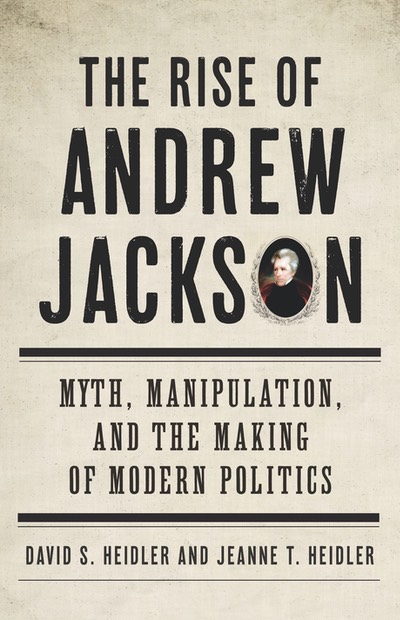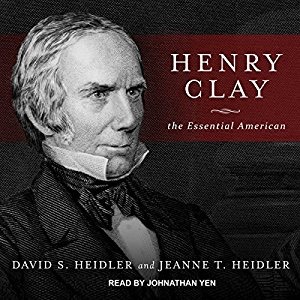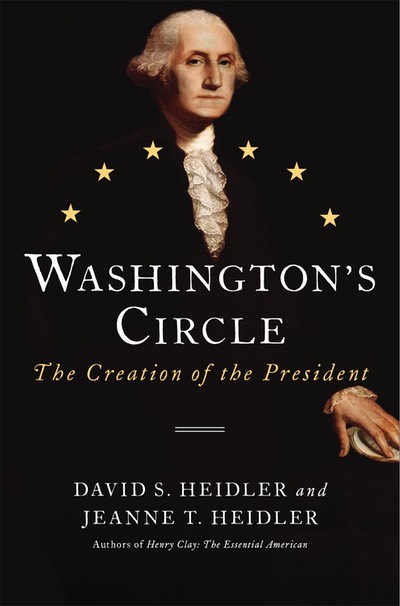Providence settled on one
the usual fate of the other
January 8 marked the 205th anniversary of the Battle of New Orleans. Commemorations of the event usually focus on the people such as the victor Major General Andrew Jackson or the losers General Sir Edward Pakenham and Admiral Sir Alexander Cochrane. Sometimes someone will mention the irony of the battle having occurred two weeks after America and British peace delegations signed the Treaty of Ghent ending the war. Yet another aspect of the clash at New Orleans is just as ironic, for it features a strange historical coincidence. Two men of the same name were involved in two pivotal events of the war. One of those men was an eccentric American. The other was a decorated British officer.
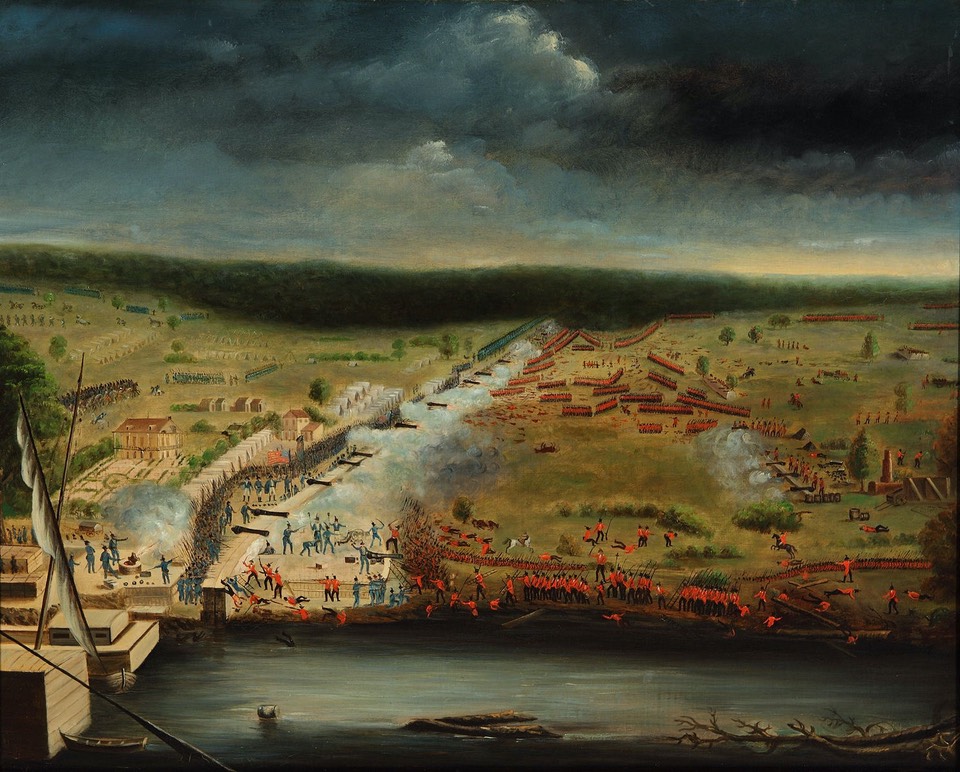
The Battle of New Orleans
The officer was William Thornton, an Irish-born career military man who had won medals and promotion for his feats in leading His Majesty’s 85th Regiment of Foot during Wellington’s Peninsula Campaign. Thornton was among those veterans of the Napoleonic Wars freed up for North American service after the first defeat of Bonaparte in the spring of 1814, and he and his regiment were part of General Robert Ross’s force that put ashore that summer in Maryland in the third year of the War of 1812. Ross’s objective was the US capital, and the 85th Foot was in the thick of things from the start.
At Bladensburg, Thornton led the charge that sent the Americans into a flight so panicked that critics dubbed the affair “the Bladensburg races.” It was a fitting role for the thirty-five-year-old who had acquired a reputation for reckless courage but also for impeccable reliability. On the Peninsula, Thornton was not just consistently punctual in executing maneuvers; he was often dependably early. He had a way of turning the tide of battles by merely showing up. His performance at Bladensburg came as no surprise then, but his impetuous bravery for once got the better of him. As American forces scattered and ran, and the British began their rapid march on Washington, DC, Thornton lay wounded and left behind. American stragglers captured him. It looked like the end of the war for him, and in losing one of their most capable officers, a considerable loss for British arms.
The American government evacuated its capital, and the British occupation was both leisurely and destructive. They set fire to the Capitol and treated themselves to the food in President James Madison’s larder while vandalizing his home and making crude jokes about his bravery and Dolley’s looks. Eventually, they put the Executive Mansion to the torch as well.
Among the evacuees from Washington was the American William Thornton, who had repaired to Georgetown with a wagonload of small contraptions and bundled documents at the same time the first shots were being fired at Bladensburg. Thornton was neither a packrat nor a coward. He was the head of the US Patent Office, and as was his custom, he was running late. His hasty gathering together of scattered and mostly uncatalogued items in the Patent Office was haphazard and random, but that too was part of his character. Even in unhurried moments, Dr. Thornton (he began his career as a physician) could have had “haphazard” as his motto and “random” as his middle name.
From his youth in a British Caribbean colony, Thornton had always indulged a scatterbrained approach to life. When he settled in Philadelphia in 1787, the heady atmosphere of that city’s intellectual vibrancy encouraged his already eclectic nature. Though educated in medicine at Aberdeen, he dabbled in architecture, engineering, botany, and anything else that struck his fancy. He won the contest for the design of the US Capitol, much to the dismay of more experienced competitors. Still, his plan was so imaginative it couldn’t be achieved without busting budgets and ignoring the calendar. Thornton was never prideful about such matters, and he cheerfully consented to changes that made the project thriftier and more manageable. Accustomed to coping with temperamental architects, George Washington and Thomas Jefferson were forever grateful. President Jefferson even appointed Thornton to head the Patent Office in 1803 despite Thornton’s reputation for eccentricity. In 1799, for example, he had arrived at Mount Vernon for George Washington’s funeral with the suggestion to inject Washington’s corpse with lamb’s blood to restore him to life. The awkward pause that followed this proposal persuaded Thornton to drop the idea.
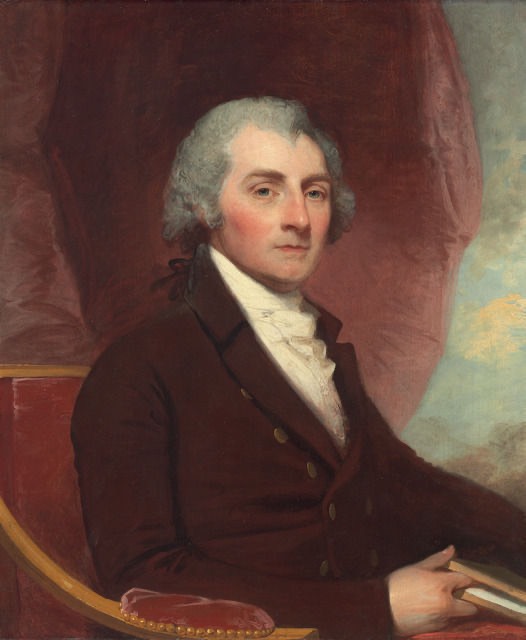
Dr. William Thornton
The Patent Office was hardly a plum job. The department had to share space with the more prestigious Post Office on Eighth Street, but Thornton basked in the post even if he proved typically disorganized in it. The passing years saw enough patents issued to prevent inquiries. However, some applications and models went unrecorded and were still gathering dust in the office’s dark corners when news of the British invasion sent Thornton into an uncharacteristic frenzy. He loaded up what he could in catch-as-catch-can fashion, drove the bulging wagon to Georgetown, and spent the night forlornly watching the skies alight with the flames of the Capitol and Presidential Palace.
The next day brought the relatively happy report that the building on Eighth Street still stood. Thornton impulsively headed into Washington to save more inventory. He arrived at the Patent Office just as British soldiers were preparing to set it on fire. Thornton implored the young officer to spare the building. Destroying the intellectual legacy of invention and innovation it contained would be, cried William Thornton, an act of irredeemable barbarism. The soldiers stopped as their young officer frowned, paused, and disappeared to consult a superior. When he returned, he called the entire operation off, and Thornton sighed in relief. By the merest stroke of luck, he had arrived in the nick of time.
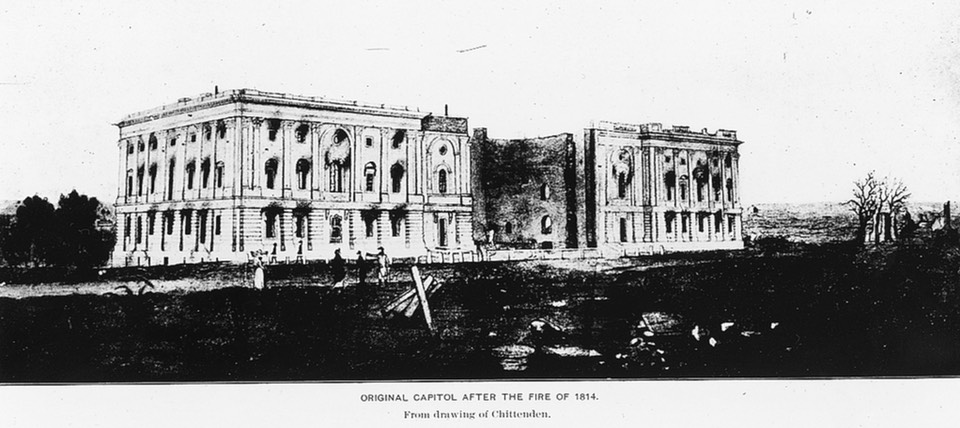
An artist’s rendering of the destroyed US Capitol shows what could have been the fate of the Patent Office
The other William Thornton meanwhile mended in captivity, which ended in October 1814 when he returned to his army by way of a prisoner exchange. Col. Thornton had missed the repulse of General Ross’s army at Baltimore, where a sniper had killed Ross. When Thornton rejoined the 85th Foot in Jamaica, the army was under the command of General John Keane, and Thornton was true to form in being right on time for the new campaign being organized to take New Orleans. And just as always, Thornton was in the thick of things from the start. He led his regiment in the advance parties that landed at Pine Island on Lake Borgne that December.
Yet delay and hesitation came from ranks above Thornton’s. Logistical snarls and abysmally cold weather also worked to retard British plans and gave Andrew Jackson time to dig in a line at the Rodriguez Canal, reinforce it, and then fortify it even more. Consequently, when Sir Edward Pakenham took command of the British force outside New Orleans in late December, he didn’t care at all for what he saw. A few probing assaults on Jackson’s line always came back bloodied.
The British were not discouraged, however. After all, veterans who had defeated Napoleon were to attack a ragtag gaggle of “dirty shirts,” the kind of mob that had scattered like frightened rabbits at the Bladensburg races. Pakenham dispensed with trial strikes and scheduled his major assault.
Though Pakenham didn’t think it necessary, he consented to send a detachment to the western bank of the Mississippi, where Americans had moored a floating artillery battery. Those guns in British hands would be able to run off the American ship protecting Jackson’s right flank and could even lob shells into the right of Jackson’s line to soften it up for the main British assault. If that part of the American line anchored on the Mississippi crumpled, the British could conceivably roll the entire position up like a carpet. New Orleans would be Pakenham’s for the taking.
Timing was everything for the operation against the American battery. It was a job that called for the army’s most obsessively reliable officer commanding its most consistently dependable regiment. Col. William Thornton and his trusty “Bucks Volunteers” (the 85th’s nickname for having been originally raised in Buckinghamshire) were to be accompanied by a contingent of sailors and Royal Marines. But by the time this force pushed off for the western bank during the night of January 7, it was already eight hours behind schedule. The men had to drag their boats through a recently cut canal to reach the Mississippi, and even their considerable effort left them woefully short of transport. Two-thirds of the contingent had to stay behind. Trouble continued when the reduced force had to fight the Mississippi’s strong current to prevent being pushed downstream. Keeping the boats together proved almost impossible. The only advantage was a rolling fog that shrouded the river and Thornton’s approach to the American position. He did not reach the West Bank until daybreak, though, and by then, he could hear the muffled sound of artillery across the water. The battle had started. He was late.
The fog that hid Thornton also cloaked the Chalmette Plain in front of Jackson’s line, and Pakenham judged it the perfect cover for bringing his army in close with a minimum of casualties. His plan to use the unexpected advantage of the fog was one of the reasons Pakenham didn’t wait for Thornton to take the American battery before launching the main assault.
The eerie sound of shrill bagpipes and the mournful cadence of regimental drums brought the British on to the Chalmette Plain. But the dense fog gradually turned to wisps and soon vanished altogether. Jackson’s artillery opened up, and riflemen accustomed to dropping squirrels at some distance found the larger targets wearing redcoats coming closer in massed ranks impossible to miss. The American line didn’t break and run as it had at Bladensburg. These Americans stood and fired. They fired en masse and then at will, firing and reloading to fire again, repeating the lethal drill for about thirty minutes until Pakenham lay dead with his army broken and the battle over. In front of the Rodriguez Canal were almost 300 British corpses. Four times that number were wounded. An additional 500 hardened veterans of the European wars lay motionless among their dead and injured, hoping the pretense would save their lives and eager to raise hands in surrender when the Americans moved among them. American losses totaled six men killed and seven wounded.
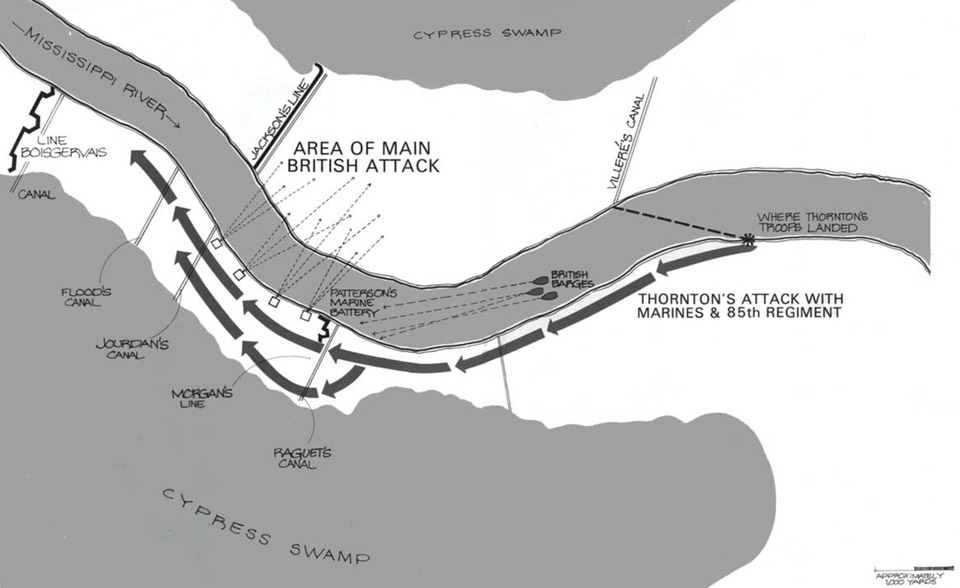
Col. Thornton’s attack was finally successful, but it was also too late to make any difference
Across the river, William Thornton had fought a sharp engagement to take the American battery, but he suffered a serious wound and had to turn over command to a lieutenant colonel of 85th. Neither Thornton’s small victory or his injury mattered, though. Orders soon came from Pakenham’s successor across the river to quit the position and return for a general British withdrawal to the gulf.
Months separated the exploits of the two Thorntons at the end of the War of 1812, two episodes in which their fortunes were reversed. Providence, seemingly confused by the monikers, settled on one the usual fate of the other. Dr. William Thornton, the confirmed eccentric whose absentminded habits made him chronically late, was right on time at a critical moment to save the US Patent Office. At New Orleans, Col. William Thornton, the flawless professional who counted seconds and overcame all hazards to fulfill any mission earlier than scheduled, was for whatever reason late at the crucial moment in the Battle of New Orleans. The guns that could have made all the difference remained uncaptured until it was too late.
After the war, the two Thorntons reverted to type. The American eccentric haphazardly superintended the Patent Office until his death in 1828. The British officer healed up, it seemed, to resume his stellar career collecting plaudits, earning promotions, and holding important administrative posts. He never received the slightest criticism for this failure to take the American battery in a timely fashion on January 8, 1815, perhaps because the British disaster at New Orleans was such a complete catalogue of incompetence that his part in it was deemed incidental.
But William Thornton apparently could not shake the memory of that day. It seems to have become a heavy burden for him that in the end he could no longer bear. He settled in Greenford, a peaceful village in Middlesex, but he could find no peace. Gradually, as was later noted, he became “delusional.” He was only sixty-one when he killed himself with a pistol.
